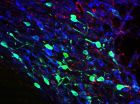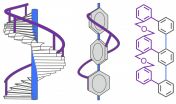NIDA researchers confirm important brain reward pathway
NIH study in rodents identifies a pathway that starts with glutamate and ends with activation of dopamine reward system
2014-11-12
(Press-News.org) Details of the role of glutamate, the brain's excitatory chemical, in a drug reward pathway have been identified for the first time.
This discovery in rodents - published today in Nature Communications - shows that stimulation of glutamate neurons in a specific brain region (the dorsal raphe nucleus) leads to activation of dopamine-containing neurons in the brain's reward circuit (dopamine reward system).
Dopamine is a neurotransmitter present in regions of the brain that regulate movement, emotion, motivation, and feelings of pleasure. Glutamate is a neurotransmitter whose receptors are important for neural communication, memory formation, and learning. The research was conducted at the Intramural Research Program (IRP) of the National Institute on Drug Abuse (NIDA), which is part of the National Institutes of Health.
The research focused on the dorsal raphe nucleus, which has long been a brain region of interest to drug abuse researchers, since nerve cells in this area connect to part of the dopamine reward system. Many of the pathways are rich in serotonin, a neurotransmitter linked to mood regulation. Even though electrical stimulation of the dorsal raphe nucleus promotes reward-related behaviors, drugs that increase serotonin have low abuse potential. As a result, this region of the brain has always presented a seeming contradiction, since it is involved in drug reward but is also abundant in serotonin - a chemical not known for a role in drug reinforcement. This has led researchers to theorize that another neurotransmitter may be responsible for the role that the dorsal raphe nucleus plays in reward.
"We now have strong evidence of a reward pathway that starts with stimulation of glutamate neurons in the dorsal raphe nucleus and ends in activation of the dopamine reward system," said NIDA Director Dr. Nora D. Volkow. "These findings help us better understand the brain's reward circuitry and opens up new avenues of research into the neurobiology of drug addiction."
In these rodent models, researchers used special tracers and labelling compounds to confirm that this circuit in the reward pathway begins with glutamate cells in the dorsal raphe nucleus that connect to dopamine cells in the ventral tegmental area, which in turn travel to the nucleus accumbens, a brain structure linked to motivation, pleasure, and reward. After verifying the pathway, investigators used optogenetic techniques (using light to control activity of modified cells) and chemical blockers to confirm that glutamate, not serotonin, is responsible for activating this reward circuitry.
"This glutamatergic pathway is the first fully characterized link between electrically stimulated reward circuitry and the dopamine system on which it depends," said Dr. Marisela Morales, NIDA IRP scientist and senior author on the paper. "The discovery of this specific brain pathway opens new avenues to examine its participation in a variety of disorders related to motivation."
INFORMATION:
The paper by Qi et al. can be found at http://www.nature.com/ncomms/index.html. For similar research currently being conducted by NIDA IRP in this area, go to: http://irp.drugabuse.gov/cnrb.php#Anchor-Anatomy-48213.
The National Institute on Drug Abuse is a component of the National Institutes of Health, U.S. Department of Health and Human Services. NIDA supports most of the world's research on the health aspects of drug abuse and addiction. The Institute carries out a large variety of programs to inform policy and improve practice. Fact sheets on the health effects of drugs of abuse and information on NIDA research and other activities can be found on the NIDA home page at http://www.drugabuse.gov, which is now compatible with your smartphone, iPad or tablet. To order publications in English or Spanish, call NIDA's DrugPubs research dissemination center at 1-877-NIDA-NIH or 240-645-0228 (TDD) or fax or email requests to 240-645-0227 or drugpubs@nida.nih.gov. Online ordering is available at http://drugpubs.drugabuse.gov. NIDA's media guide can be found at http://drugabuse.gov/mediaguide/, and its new easy-to-read website can be found at http://www.easyread.drugabuse.gov.
About the National Institutes of Health (NIH): NIH, the nation's medical research agency, includes 27 Institutes and Centers and is a component of the U.S. Department of Health and Human Services. NIH is the primary federal agency conducting and supporting basic, clinical, and translational medical research, and is investigating the causes, treatments, and cures for both common and rare diseases. For more information about NIH and its programs, visit http://www.nih.gov.
[Attachments] See images for this press release:

ELSE PRESS RELEASES FROM THIS DATE:
2014-11-12
HANOVER, N.H. - China's anti-logging, conservation and ecotourism policies are accelerating the loss of old-growth forests in one of the world's most ecologically fragile places, according to studies led by a Dartmouth College scientist.
The findings shed new light on the complex interactions between China's development and conservation policies and their impact on the most diverse temperate forests in the world, in "Shangri-La" in northwest Yunnan Province. Shangri-La, until recently an isolated Himalayan hinterland, is now the epicenter of China's struggle to wed sustainable ...
2014-11-12
The "surfactant" chemicals found in samples of fracking fluid collected in five states were no more toxic than substances commonly found in homes, according to a first-of-its-kind analysis by researchers at the University of Colorado Boulder.
Fracking fluid is largely comprised of water and sand, but oil and gas companies also add a variety of other chemicals, including anti-bacterial agents, corrosion inhibitors and surfactants. Surfactants reduce the surface tension between water and oil, allowing for more oil to be extracted from porous rock underground.
In a new ...
2014-11-12
Action movies may drive box office revenues, but dramas and deeper, more serious movies earn audience acclaim and appreciation, according to a team of researchers.
"Most people think that entertainment is just a silly diversion, but our research shows that entertainment is profoundly meaningful and moving for many people," said Mary Beth Oliver, Distinguished Professor in Media Studies and co-director of Media Effects Research Laboratory, Penn State. "It's not just types of entertainment that we usually think of as meaningful, such as poetry and dance, either, but also ...
2014-11-12
Shark populations in the Mediterranean are highly divided, an international team of scientists, led by Dr Andrew Griffiths of the University of Bristol, has shown. Many previous studies on sharks suggest they move over large distances. But catsharks in the Mediterranean Sea appear to move and migrate much less, as revealed by this study. This could have important implications for conserving and managing sharks more widely, suggesting they may be more vulnerable to over-fishing than previously thought.
The study, published in the new journal Royal Society Open Science, ...
2014-11-12
Providing health information on the internet may not be the "cure all" that it is hoped to be. It could sideline especially those Americans older than 65 years old who are not well versed in understanding health matters, and who do not use the web regularly. So says Helen Levy of the University of Michigan in the US, who led the first-ever study to show that elderly people's knowledge of health matters, so-called health literacy, also predicts how and if they use the internet. The findings¹ appear in the Journal of General Internal Medicine², published by Springer.
Substantial ...
2014-11-12
Learning a new language changes your brain network both structurally and functionally, according to Penn State researchers.
"Learning and practicing something, for instance a second language, strengthens the brain," said Ping Li, professor of psychology, linguistics and information sciences and technology. "Like physical exercise, the more you use specific areas of your brain, the more it grows and gets stronger."
Li and colleagues studied 39 native English speakers' brains over a six-week period as half of the participants learned Chinese vocabulary. Of the subjects ...
2014-11-12
The tree has been an effective model of evolution for 150 years, but a Rice University computer scientist believes it's far too simple to illustrate the breadth of current knowledge.
Rice researcher Luay Nakhleh and his group have developed PhyloNet, an open-source software package that accounts for horizontal as well as vertical inheritance of genetic material among genomes. His "maximum likelihood" method, detailed this month in the Proceedings of the National Academy of Sciences, allows PhyloNet to infer network models that better describe the evolution of certain ...
2014-11-12
Most community-based mental health providers are not well prepared to take care of the special needs of military veterans and their families, according to a new study by the RAND Corporation that was commissioned by United Health Foundation in collaboration with the Military Officers Association of America.
The exploratory report, based on a survey of mental health providers nationally, found few community-based providers met criteria for military cultural competency or used evidence-based approaches to treat problems commonly seen among veterans.
"Our findings suggest ...
2014-11-12
A new study from The University of Texas at Arlington biologists examining non-genetic changes in water flea development suggests something human parents have known for years - ensuring a future generations' success often means sacrifice.
Matthew Walsh, an assistant professor of biology, and his team looked at a phenomenon called "phenotypic plasticity" in the Daphnia abigua, or water flea. Phenotypic plasticity is when an organism changes its trait expressions or physical characteristics, or those of its offspring, because of external factors. In Daphnia, that can mean ...
2014-11-12
Chemists at the University of Basel in Switzerland have succeeded in twisting a molecule by combining molecular strands of differing lengths. The longer strand winds around a central axis like a staircase banister, creating a helical structure that exhibits special physical properties. The results were published in the renowned scientific journal Angewandte Chemie International Edition.
The chemistry of all substances is to a large extent defined by their spatial arrangement. Many molecules can be present in two forms (enantiomers), which behave like a person's right ...
LAST 30 PRESS RELEASES:
[Press-News.org] NIDA researchers confirm important brain reward pathway
NIH study in rodents identifies a pathway that starts with glutamate and ends with activation of dopamine reward system





